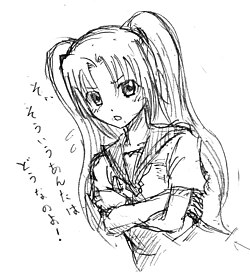Tsundere

| Part of a series on |
| Anime and manga |
|---|
 |
|
|
Tsundere (ツンデレ, pronounced [t͡sɯndeɾe]) is a Japanese term for a character development process that depicts a character with an initially harsh personality who gradually reveals a warmer, friendlier side over time.
The word is derived from the terms tsun tsun (
Another accepted definition of tsundere is someone who has a combative attitude towards others but is also kind on the inside.[citation needed]
Terminology
Manga author
Tsundere as a concept is not strictly limited to women, and is not strictly limited to manga or anime. The character Germany from the series Hetalia: Axis Powers is portrayed as being tsundere, and is paired with a "lovable loser", Italy Veneziano.[7] Tsundere role-play has become a common theme in maid cafés.[7]
See also
- Ambivalence
- Glossary of anime and manga
- Hawksian woman
- Love-hate relationship
- Queen bee (sociology)
- Shrew (stock character)
Notes
- Mainichi Times.
- ^ "Toy manufacturer Tomy Co. has come up with the world's first tsundere portable television set, which gives audio guidance with a harsh voice that gradually becomes kinder as the user gets used to the set... Tsundere is a word for a type of feminine personality that is initially uptight and cold, and then kind and loving. It is well known among Japan's otaku community, and ranks in popularity with the word moe, which signifies an enthusiasm or fetish for something, especially in connection with anime." February 2, 2007, Mainichi
References
- ^ Nihon Kokugo Daijiten, entry for tsuntsun available online here Archived March 17, 2023, at the Wayback Machine (in Japanese)
- ^ a b Daijirin, second edition, 1995
- ^ Digital Daijisen, entry for tsuntsun available online here Archived March 17, 2023, at the Wayback Machine (in Japanese)
- ^ Nihon Kokugo Daijiten, entry for deredere available online here Archived March 17, 2023, at the Wayback Machine (in Japanese)
- ^ Digital Daijisen, entry for deredere available online here Archived March 17, 2023, at the Wayback Machine (in Japanese)
- ^ ISBN 978-1421508467.
This is an attempt to translate the concept of tsundere (this illustration and the "tsundere?" slogan appeared on the back of the slipcover on the original Japanese Vol. 15...); a character description sometimes used in dating-sim games. Note that it has been demonstrated previously in Excel Saga that Matsuya has to be virtually be on the brink of death in order to display softness.
- ^ a b c Galbraith, Patrick W. (October 31, 2009). "Moe: Exploring Virtual Potential in Post-Millennial Japan". Electronic Journal of Contemporary Japanese Studies. Archived from the original on June 18, 2012. Retrieved March 4, 2010.
- ISBN 978-4-7700-3101-3.
- ^ "Wednesday Notes... Akamatsu-sensei Talks "Moe"". Matthew's Anime Blog. Anime blogger. July 20, 2005. Archived from the original on March 2, 2010. Retrieved November 11, 2009.
- ^ "【ファンキー通信】タメ口、暴言の接客もなんのその! ツンデレカフェ登場!?" (in Japanese). March 22, 2006. Archived from the original on November 4, 2016. Retrieved November 4, 2016.
- ISBN 978-4-7700-3101-3.
Lum-chan is the source of moe, the queen. She's the first tsundere character.
- ^ Ruh, Brian (December 14, 2010). "Brain Diving: Otaku, Where Art Thou?". Anime News Network. Archived from the original on December 16, 2010. Retrieved January 3, 2010.
- ^ Thompson, Jason (September 11, 2014). "House of 1000 Manga – Kimagure Orange Road". Anime News Network. Archived from the original on September 12, 2014. Retrieved September 15, 2015.
For historical value, yes: this is the root from which all modern shonen rom-coms grew. (Including the tsundere archetype, which Madoka basically embodies.)
- ^ Eisenbeis, Richard (August 20, 2013). "How to Identify Popular Japanese Character Types". Kotaku.com. Archived from the original on August 4, 2014. Retrieved October 20, 2013.
- ISBN 978-4-06-283602-9.
They call my character 'tsundere', don't they?
- ^ 声優アワード:「ツンデレの女王」釘宮理恵さんが主演女優賞に 神谷浩史さん二冠達成 [Seiyu Award: "Tsundere Queen" Rei Kugimiya Gets Starring Actress Award, Hiroshi Kamiya Also Awarded]. Mainichi Shimbun (in Japanese). March 7, 2009. Archived from the original on February 3, 2010. Retrieved November 11, 2009.
- ^ ツンデレカルタ:「私の気持ちも知らないで...」"女王"釘宮理恵が読み手 緊急発売へ [Tsundere Card Game: 'Please Don't Understand My Feelings' "Queen" Rie Kugimiya as the Reader to be Sold Soon]. Mainichi Shimbun (in Japanese). December 10, 2007. Archived from the original on January 12, 2008. Retrieved November 11, 2009.
- ^ "Interview: Seiyuu Ayana Taketatsu at Anime Festival Asia 2015". Archived from the original on March 6, 2023. Retrieved March 6, 2023.
Further reading
- Togashi, J. (2009). ツンデレ属性と言語表現の関係―ツンデレ表現ケーススタディ― [Tsundere expression case study - of a tsundere attribute and the verbalization concerned] (PDF) (in Japanese). Daito Bunka University.
